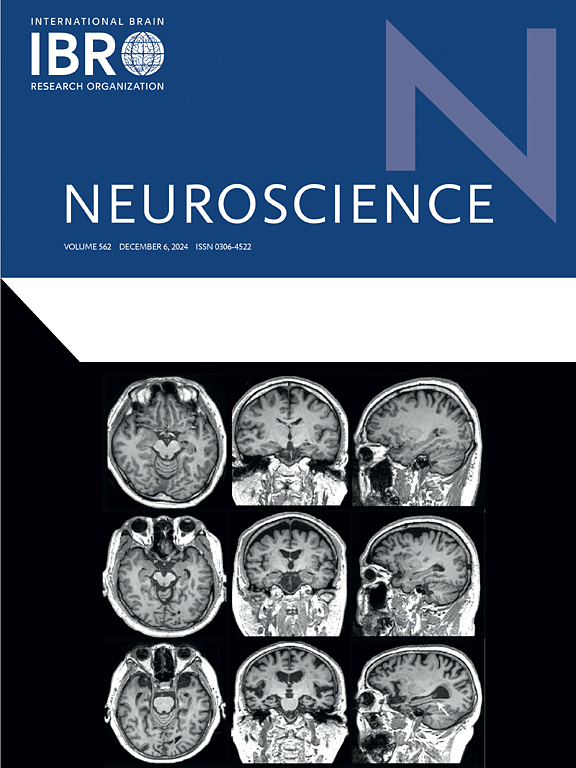Rett综合征小鼠后肢躯体感觉皮层重复性触觉刺激后皮层感觉适应持续性受损。
IF 2.8
3区 医学
Q2 NEUROSCIENCES
引用次数: 0
摘要
对重复刺激的反应减弱是感觉系统的一个显著特征。在这项研究中,我们检测了年轻雄性、年轻和年老雌性小鼠在RS之前、期间和之后对足/脚踝短暂触觉刺激的皮质感觉反应。我们比较了野生型(WT)小鼠和Mecp2突变导致神经发育障碍Rett综合征(RTT)的小鼠的皮质活动。本征光信号成像(IOS)和皮层内局部场电位(LFP)测量结果显示,在15分钟的RS刺激后,皮层对测试刺激的反应减少了40-50%,在RS刺激前和施加RS刺激时,WT和RTT小鼠的IOS和LFP对触觉测试刺激的反应减少的时间过程和幅度相似。停止RS后,WT小鼠的皮质反应持续低于刺激前,而RTT小鼠的恢复速度明显更快,在某些情况下,休息一小时后完全恢复。在7刺激测试训练中,LFP对每个刺激的反应都呈下降趋势。通过测试训练过程中这种适应性的形成,研究人员发现,虽然对测试训练中第一个刺激的反应大体上是一致的,但在使用RS后,对测试训练中连续刺激的反应下降得更快。在测试训练中,WT小鼠的适应性持续增强,而RTT小鼠的适应性逆转得更快,这表明持续的皮层感觉适应是由负责短期适应的过程的增强引起的。RTT小鼠缺乏持续的皮质感觉适应可能反映了中央体感处理回路的长期可塑性降低。本文章由计算机程序翻译,如有差异,请以英文原文为准。
Impaired persistence of cortical sensory adaptation following repetitive tactile stimulation in the hindlimb somatosensory cortex of Rett syndrome mice
Reduced response to repeated stimulation (RS) is a signature feature of sensory systems. In this study we examined cortical sensory responses to brief tactile stimulation of the foot/ankle before, during and after periods of RS in young male, young and old female mice. We compared cortical activity in wild-type (WT) mice to mice with mutation in Mecp2 that causes the neurodevelopmental disorder Rett syndrome (RTT). Intrinsic optical signal imaging (IOS) and intracortical local field potential (LFP) measurements revealed reduced cortical responses to test stimuli on the order of 40–50% after 15-min periods of RS. The time-course and magnitude of reduced IOS and LFP to tactile test-stimuli were similar in WT and RTT mice before and during application of RS. However, after cessation of RS, cortical responses remained persistently below pre-stimulation in WT while RTT mice had significantly more rapid and in some cases complete recovery with an hour of rest. LFP responses to each stimulus in a 7-stimulus test-train characteristically decline. Examining the buildup of this adaptation during test-trains revealed that while the response to the first stimulus in the test-train was generally consistent, responses to successive stimuli in the test-train declined more rapidly after application of RS. This increased adaptation during test-trains persisted in WT mice and reversed more rapidly in RTT mice suggesting that persistent cortical sensory adaptation results from enhancement of processes responsible for short-term adaptation. The lack of persistent cortical sensory adaptation in RTT mice may reflect reduced long-term plasticity within central somatosensory processing circuits.
求助全文
通过发布文献求助,成功后即可免费获取论文全文。
去求助
来源期刊

Neuroscience
医学-神经科学
CiteScore
6.20
自引率
0.00%
发文量
394
审稿时长
52 days
期刊介绍:
Neuroscience publishes papers describing the results of original research on any aspect of the scientific study of the nervous system. Any paper, however short, will be considered for publication provided that it reports significant, new and carefully confirmed findings with full experimental details.
 求助内容:
求助内容: 应助结果提醒方式:
应助结果提醒方式:


